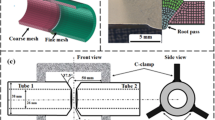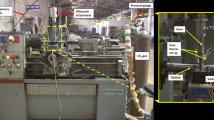Abstract
The aim of the research is to evaluate the 3-D temperature distribution in the friction stir welding (FSW) joints of AA1100 alloy plates by using Finite difference method. The theoretical results are correlated with experimental output in terms of temperature profiles of the weld zones. Microstructure analysis and tensile test have been conducted to determine the joint quality that strongly depends on the amount of heat generation which again is governed by the processing parameters. Microstructure of the weld samples clearly shows the grain refinement in the weld zone. The friction coefficient is also an important factor that totally depends on the tool pin design. More is the friction; sound welds are produced with minimum defects and an enhanced weld strength. This process finds its applications in the automotive industries as the demand for better performance in joining components for vehicles prompts the implementation of aluminium alloy FSW technology.











Similar content being viewed by others
References
W. M. Thomas, E. D. Nicholas, J. C. Needham, M. G. Murch, P. Temple-Smith, C. J. Dawes. Friction Welding, October 24 1995, US Patent 5, 460, 317.
P.A. Colegrove, H.R. Shercliff, R. Zettler, Model for predicting heat generation and temperature in friction stir welding from the material properties. Sci. Technol. Weld. Join. 12(4), 284–297 (2007). https://doi.org/10.1179/174329307X197539
H.B. Schmidt, J.H. Hattel, Thermal modeling of friction stir welding. Scripta Mater. 58, 332–337 (2008). https://doi.org/10.1016/j.scriptamat.2007.10.008
T.T. Feng, G.J. Fan, H. Zhang, L.F. Xu, Study on contact coefficient of 6061 Al-Alloy using friction stir Welding. IOP Conf. Series: Mater Sci Eng 382, 1–5 (2018). https://doi.org/10.1088/1757-899X/382/2/022086
T.F. Flint, J.A. Francis, M.C. Smith, A semi-analytical solution for the transient temperature field generated by a volumetric heat source developed for the simulation of friction stir welding. Int J Thermal Sci 138, 586–595 (2019). https://doi.org/10.1016/j.ijthermalsci.2018.12.049
A.R.S. Essa, M.M.Z. Ahmed, A.K.Y. Ahmed Mohamed, A.E. El-Nikhaily, An analytical model of heat generation for eccentric cylindrical pin in friction stir welding. J Mater Res Technol. 5(3), 234–240 (2016). https://doi.org/10.1016/j.jmrt.2015.11.009
S. Salimi, P. Bahemmat, M. Haghpanahi, A 3D transient analytical solution to the temperature field during dissimilar welding processes. Int. J. Mech. Sci. 79, 66–74 (2014). https://doi.org/10.1016/j.ijmecsci.2013.11.015
M. Haghpanahi, S. Salimi, P. Bahemmat, S. Sima, 3-D transient analytical solution based on Green’s function to temperature field in friction stir welding. Appl Mathematical Model 37, 9865–9884 (2013). https://doi.org/10.1016/j.apm.2013.05.034
Moataz M. Attallah, Microstructure-Property development in Friction stir Welds of Aluminium based alloys, PhD Thesis, University of Birmingham, (2007)
B. Zhang, X. Chen, K. Pan, M. Li, J. Wang, Thermo-mechanical simulation using microstructure-based modeling of friction stir spot welded AA 6061–T6. J. Manuf. Process. 37, 71–81 (2019). https://doi.org/10.1016/j.jmapro.2018.11.010
H. Robe, C. Claudin, J.M. Bergheau, E. Feulvarch, R-ALE simulation of heat transfer during friction stir welding of an AA2xxx/AA7xxx joint on a large process window. Int. J. Mech. Sci. 155, 31–40 (2019). https://doi.org/10.1016/j.ijmecsci.2019.02.029
B. Bagheri, M. Abbasi, M. Givi, Effects of vibration on microstructure and thermal properties of friction stir spot welded (FSSW) Aluminum Alloy (Al5083). Int. J. Precis. Eng. Manuf. 20, 1219–1227 (2019). https://doi.org/10.1007/s12541-019-00134-9
H. Li, J. Gao, Q. Li, A. Galloway, A. Toumpis, Effect of friction stir welding tool design on welding thermal efficiency. Sci. Technol. Weld. Join. 24, 156–162 (2018). https://doi.org/10.1080/13621718.2018.1495868
J.F. Villegas, J.V. Dominguez, G.V. Ochoa, J. Unfried-Silgado, Thermo-mechanical modeling of friction-stir welding tool used in aluminum alloys joints. Contemp Eng Sci 10(34), 1659–1667 (2017). https://doi.org/10.12988/ces.2017.711156
Y. Xiao, H. Zhan, Y. Gu, Q. Li, Modeling heat transfer during friction stir welding using a meshless particle method. Int J Heat Mass Trans 104, 288–300 (2017). https://doi.org/10.1016/j.ijheatmasstransfer.2016.08.047
Z. Zhang, Z.J. Tan, A multi scale strategy for simulation of microstructural evolutions in friction stir welding of duplex titanium alloy. High Temp Mater Proc 38, 485–497 (2019). https://doi.org/10.1515/htmp-2018-0148
K.A. Fraser, L. St-Georges, L.I. Kiss, Optimization of friction stir welding tool advance speed via monte-carlo simulation of the friction stir welding process. Mater 7, 3435–3452 (2014). https://doi.org/10.3390/ma7053435
R.S. Mishra, Z.Y. Ma, Friction stir welding and processing. Mater Sci Eng R Reports 50(1–2), 1–78 (2005). https://doi.org/10.1016/j.mser.2005.07.001
W. Cheney, D. Kincaid. Numerical mathematics and Computing, 6th edition, Brooks/Cole Publishing Company, California
N.P. Senapati, R.K. Bhoi, Grain size optimization using PSO technique for maximum tensile strength of friction stir-welded joints of AA1100 aluminium. Arab. J. Sci. Eng. 45, 5647–5656 (2020). https://doi.org/10.1007/s13369-020-04510-w
S.M. Bayazida, H. Farhangia, A. Ghahramani, Effect of pin profile on defects of friction stir welded 7075 aluminum alloy. Procedia Mater Sci 11, 12–16 (2015). https://doi.org/10.1016/j.mspro.2015.11.013
S.A. Hussein, S. Thiru, R. Izamshah, A.S.M. Tahir, Unstable temperature distribution in friction stir welding. Adv Mater Sci Eng 2014, 1–8 (2014). https://doi.org/10.1155/2014/980636
S. Verma, G. Meenu, J.P. Misra, Study on temperature distribution during Friction Stir Welding of 6082 aluminum alloy, 5th Int Conf Mater Process Charac (ICMPC 2016). Mater Today: Proceed 4, 1350–1356 (2017). https://doi.org/10.1016/j.matpr.2017.01.156
A. Heidarzadeh, M. Jabbari, M. Esmaily, Prediction of grain size and mechanical properties in friction stir welded pure copper joints using a thermal model. Int. J. Adv. Manuf. Technol. 77, 1819–1829 (2014). https://doi.org/10.1007/s00170-014-6543-7
K.N. Salloomi, F.I. Hussein, S.N.M. Al-Sumaidae, Temperature and stress evaluation during three different phases of friction stir welding of AA 7075–T651 alloy. Modell Simul Eng (2020). https://doi.org/10.1155/2020/3197813
H.J. Aval, S. Serajzadeh, A.H. Kokabi, Experimental and theoretical evaluations of thermal histories and residual stresses in dissimilar friction stir welding of AA5086-AA6061. Int. J. Adv. Manuf. Technol. 61, 149–160 (2012). https://doi.org/10.1007/s00170-011-3713-8
D.K. Yaduwanshi, S. Bag, S. Pal, Heat transfer analyses in friction stir welding of aluminium alloy. Proc Inst Mech Eng Part B (2014). https://doi.org/10.1177/0954405414539297
M. Zamani, Al-Si Cast Alloys - Microstructure and Mechanical Properties at Ambient and Elevated Temperature, Licentiate Thesis, Department of Materials and Manufacturing, School of Engineering, Jönköping University, Jönköping, Sweden (2015), pp. 3–15.
L. Shi, C.S. Wu, Transient model of heat transfer and material flow at different stages of friction stir welding process. J. Manuf. Process. 25, 323–339 (2017). https://doi.org/10.1016/j.jmapro.2016.11.008
N.D. Ghetiya, K.M. Patel, A.B. Patel, Prediction of temperature at weldline in air and immersed friction stir welding and its experimental validation. Int. J. Adv. Manuf. Technol. 79, 1239–1246 (2015). https://doi.org/10.1007/s00170-015-6906-8
J.Y. Sheikh-Ahmad, F. Ozturk, F. Jarrar, Z. Evis, Thermal history and microstructure during friction stir welding of Al–Mg alloy. Int. J. Adv. Manuf. Technol. 86, 1071–1081 (2016). https://doi.org/10.1007/s00170-015-8239-z
K. Kumar, C. Kalyan, S.V. Kailas, T.S. Srivatsan, An investigation of friction during friction stir welding of metallic materials. Mater. Manuf. Process. 24(4), 438–445 (2009). https://doi.org/10.1080/10426910802714340
B. Meyghani, M. Awang, S. Emamian, A mathematical formulation for calculating temperature dependent friction coefficient values: application in friction stir welding (FSW). Defect and Diffusion Forum, ISSN 1662–9507(379), 73–82 (2017)
H.J. Liu, H. Fujii, M. Maeda, K. Nogi, Mechanical properties of friction stir welded joints of 1050–H24 aluminium alloy. Sci. Technol. Weld. Join. 8(6), 450–454 (2003). https://doi.org/10.1179/136217103225005598
F.F. Wang, W.Y. Li, J. Shen, S.Y. Hu, J. Santos, Effect of tool rotational speed on the microstructure and mechanical properties of bobbin tool friction stir welding of Al–Li alloy. Mater. Des.. 86, 933–940 (2015). https://doi.org/10.1016/j.matdes.2015.07.096
Z.L. Hu, X.S. Wang, S.J. Yuan, Quantitative investigation of the tensile plastic deformation characteristic and microstructure for friction stir welded 2024 aluminum alloy. Mater Charact 73, 114–123 (2012). https://doi.org/10.1016/j.matchar.2012.08.007
Z. Chen, S. Li, L. H. Hihara, Microstructure, mechanical properties and corrosion of friction stir welded 6061 Aluminium alloy, Hawaii Corrosion Laboratory, University of Hawaii at Manoa, Honolulu, HI 96822, USA
H.J. Liu, J.C. Hou, H. Guo, Effect of welding speed on microstructure and mechanical properties of self-reacting friction stir welded 6061–T6 aluminum alloy. Mater. Des. 50, 872–878 (2013). https://doi.org/10.1016/j.matdes.2013.03.105
Z.Y. Ma, R.S. Mishra, M.W. Mahoney, Superplastic deformation behavior of friction stir processed. 7075 Al alloy. Acta Mater. 50, 4419–4430 (2002). https://doi.org/10.1016/S1359-6454(02)00278-1
J.Q. Su, T.W. Nelson, R. Mishra, M. Mahoney, Microstructural investigation of friction stir welded 7050–T651 aluminium. Acta Mater. 5, 713–729 (2003). https://doi.org/10.1016/S1359-6454(02)00449-4
C. Hamilton, S. Dymek, M. Blicharski, A model of material flow during friction stir welding. Mater Charact 59, 1206–1214 (2008). https://doi.org/10.1016/j.matchar.2007.10.002
Funding
This research did not receive any specific grant from funding agencies in public, commercial or not-for-profit sectors.
Author information
Authors and Affiliations
Corresponding author
Ethics declarations
Conflict of interests
The authors declare that they have no known competing financial interests or personal relationships that could have appeared to influence the work reported in this paper.
Additional information
Publisher's Note
Springer Nature remains neutral with regard to jurisdictional claims in published maps and institutional affiliations.
Rights and permissions
Springer Nature or its licensor (e.g. a society or other partner) holds exclusive rights to this article under a publishing agreement with the author(s) or other rightsholder(s); author self-archiving of the accepted manuscript version of this article is solely governed by the terms of such publishing agreement and applicable law.
About this article
Cite this article
Senapati, N.P., Bhoi, R.K. Numerical Analysis of Temperature Distribution in AA1100 Friction-Stir Welded Joints by Finite Difference Approximation. Multiscale Sci. Eng. (2024). https://doi.org/10.1007/s42493-024-00114-w
Received:
Revised:
Accepted:
Published:
DOI: https://doi.org/10.1007/s42493-024-00114-w




